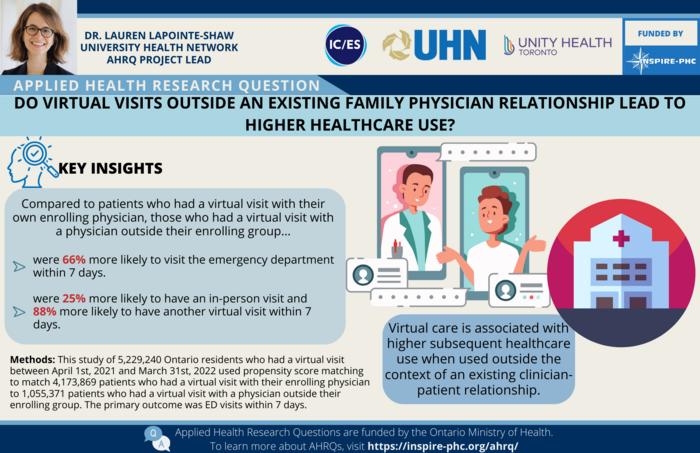Toronto, ON, December 27, 2023 – Compared to patients who had a virtual visit with their own family doctor, those who received virtual care from a doctor outside of their family care team were 66 percent more likely to visit the emergency department within seven days, according to new research.

Credit: University Health Network (UHN)
Toronto, ON, December 27, 2023 – Compared to patients who had a virtual visit with their own family doctor, those who received virtual care from a doctor outside of their family care team were 66 percent more likely to visit the emergency department within seven days, according to new research.
The study, led by researchers at the University Health Network (UHN), Unity Health Toronto, and ICES, also showed that patients receiving virtual care outside of an existing family doctor-patient relationship were 25 percent more likely to have an in-person visit and 88 percent more likely to have another virtual visit within seven days.
“This study sheds light on how different types of virtual care impact downstream healthcare use—our findings show that the relationship between a patient and their virtual care doctor makes a difference,” says lead author Dr. Lauren Lapointe-Shaw, Adjunct Scientist with ICES, General Internal Medicine physician, and Scientist at UHN, and Innovation Fellow at the Women’s College Hospital Institute for Health System Solutions and Virtual Care.
“Within an existing and ongoing relationship with a physician, patients are less likely to go elsewhere for further care,” adds Dr. Lapointe-Shaw.
Published in the journal JAMA Network Open, the study included over 5 million Ontario residents who had a family doctor and had a virtual visit between April 2021 and March 2022, and methods were used to match 4.1 million patients whose virtual visit was with their own physician, and 1 million patients whose visit was with an outside physician.
In a secondary analysis, the researchers found that patients using “direct-to-consumer” telemedicine clinics were three times more likely to visit the emergency department within seven days, compared to patients seeing their own family doctor. “Direct-to-consumer” clinics are virtual-only walk-in clinics, and they offer on-demand virtual care without an in-person exam.
More than 6.5 million people in Canada don’t have a family physician, and virtual care is believed to be an important access point for patients.
“Virtual care done right can improve timely access to care—both for people who do and don’t have a family doctor,” says co-author Dr. Tara Kiran, Adjunct Scientist at ICES and a family physician at St. Michael’s Hospital of Unity Health Toronto. “But if it’s not integrated with in-person care, or delivered by someone who has access to your health history, there is a risk that we’re adding more churn to the system.”
The data used for this study cannot tell us why patients with their own family doctor chose to have a virtual visit with an outside physician. This decision could relate to access challenges, convenience, or other factors, and further research is warranted.
Nonetheless, these findings support the use of primary care virtual services within an existing physician-patient relationship.
The study, “Virtual visits with own family physician versus an outside family physician and emergency department use” was published in JAMA Network Open.
Authors: Lapointe-Shaw L, Salahub C, Bird C, Bhatia RS, Desveaux L, Glazier RH, Hedden L, Ivers NM, Martin D, Na Y, Spithoff S, Tadrous M, Kiran T.
ICES is an independent, non-profit research institute that uses population-based health information to produce knowledge on a broad range of healthcare issues. Our unbiased evidence provides measures of health system performance, a clearer understanding of the shifting healthcare needs of Ontarians, and a stimulus for discussion of practical solutions to optimize scarce resources. ICES knowledge is highly regarded in Canada and abroad and is widely used by government, hospitals, planners, and practitioners to make decisions about care delivery and to develop policy. For the latest ICES news, follow us on X, formerly known as Twitter: @ICESOntario
About University Health Network
University Health Network consists of Toronto General and Toronto Western Hospitals, the Princess Margaret Cancer Centre, Toronto Rehabilitation Institute, and The Michener Institute of Education at UHN. The scope of research and complexity of cases at University Health Network has made it a national and international source for discovery, education and patient care. It has the largest hospital-based research program in Canada, with major research in cardiology, transplantation, neurosciences, oncology, surgical innovation, arthritis, vision, infectious diseases, genomic medicine and rehabilitation medicine. University Health Network is a research hospital affiliated with the University of Toronto. For more information: www.uhn.ca
About St. Michael’s
St. Michael’s Hospital provides compassionate care to all who enter its doors. The hospital also provides outstanding medical education to future health care professionals in more than 27 academic disciplines. Critical care and trauma, heart disease, neurosurgery, diabetes, cancer care, care of the homeless and global health are among the Hospital’s recognized areas of expertise. Through the Keenan Research Centre and the Li Ka Shing International Healthcare Education Centre, which make up the Li Ka Shing Knowledge Institute, research and education at St. Michael’s Hospital are recognized and make an impact around the world. Founded in 1892, the hospital is fully affiliated with the University of Toronto.
About Unity Health Toronto
Unity Health Toronto, comprised of St. Joseph’s Health Centre, St. Michael’s Hospital and Providence Healthcare, works to advance the health of everyone in our urban communities and beyond. Our health network serves patients, residents and clients across the full spectrum of care, spanning primary care, secondary community care, tertiary and quaternary care services to post-acute through rehabilitation, palliative care and long-term care, while investing in world-class research and education. For more information, visit www.unityhealth.to.
FOR FURTHER INFORMATION PLEASE CONTACT:
From December 21-22 and December 27:
Catherine Danko
Public Affairs Associate, UHN
647-408-5617
[email protected]
From December 23-26:
Dr. Lauren Lapointe-Shaw
Lead author on the study
[email protected]
Journal
JAMA Network Open
DOI
10.1001/jamanetworkopen.2023.49452
Method of Research
Observational study
Subject of Research
People
Article Title
Virtual Visits With Own Family Physician vs Outside Family Physician and Emergency Department Use
Article Publication Date
27-Dec-2023




